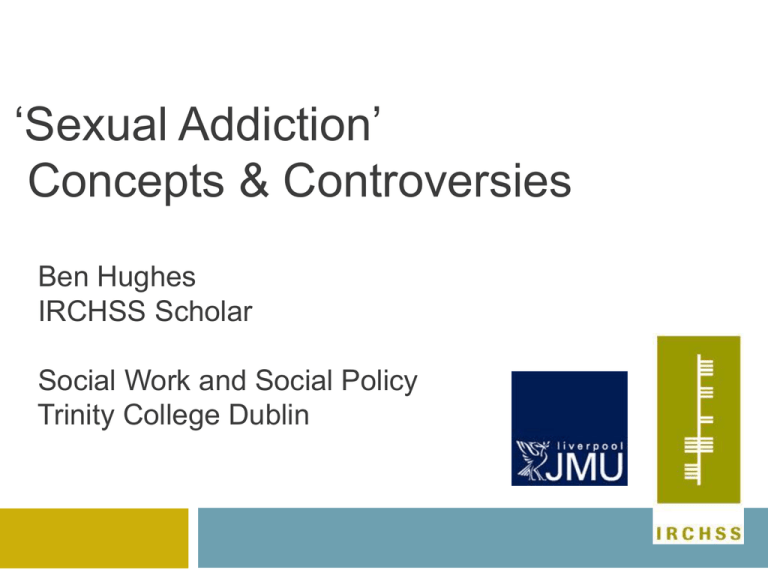
‘Sexual Addiction’
Concepts & Controversies
Ben Hughes
IRCHSS Scholar
Social Work and Social Policy
Trinity College Dublin
Overview
•
Historical Context
•
Characteristics
•
Development
•
Critique
•
Clinical Practice
•
Sexual Health Policy
•
Questions
Methodology
Ongoing Research Study
44
Treatment providers
45
Self-identified ‘Sex Addicts’
Pilot,
Focus, Interviews, Questionnaires
Historical & Cultural Context
Excessive Sexual Behaviour
Moral,
Medical, Addiction, Psychiatric Disorder
Contemporary Terminology
Sexual
Addiction, Hypersexuality, Compulsive
Sexual Addiction
‘Any sexually-related, compulsive behavior
which interferes with normal living and
causes severe stress . . . .’
Carnes (1983)
Characteristics
Out of Control
Self Destructive
Desire to Limit
Coping Mechanism
Increasing Amounts
Mood Changes
Neglectful
Not due to Drug Use or Medication
Behavioural Expressions
•
Masturbation
Pornography
Sexual Behavior with Consenting Adults
Cybersex
Telephone Sex
Strip Clubs, Adult Stores
Other
•
Normative
•
•
•
•
•
•
Development of Concept
1. Socio-Cultural
1960s
-1980s: Sexual Revolution - Sex Negative Period
2. Medicalisation
Human
Conditions vs Treatable Disorders: Addiction Medicine
3. Moral
Religious
Decline: Rise of Political Conservatism & Moral Rigidity
Recreational – Commitment ethic
Facilitated - Sexual Addiction
Abandon
Critique
Socio-Medical Construct
Pathologises
Non-Conventional Sex
Inaccurate ‘Diagnosis’
Hypersexuality
- Physiological & Psychological
Managed = Hypersexuality Discontinues
Underlying Issues Remain Unresolved
Sexual Addiction
Useful ‘Diagnosis’
Or
Label which ‘threatens the civil rights of
sexually variant people’
Hart & Wellings (2002)
Implications of Diagnostic Labels
Reductionist vs Expansive View of Sexuality
Anti
Sex Culture & Minorities ‘Re-Diagnosed’
Medicalisation
Surveillance
& industry expands
Clinical Practice
Not Presented
Disclosure, Not Recognised
Symptoms: STD’s, Genital Injury, Abuse, Depression
Pre Disposing Factors
Home,
School, Religion, Cultural
Motivation
Escapism,
Emotional Regulation, Power, Intimacy
Differential Diagnosis
Medical conditions & hypersexuality
Attend to concurrent psychiatric disorders
Is
it an independent or a coexisting condition or...?
Sexual Health Policy UK
The National Strategy for Sexual Health & HIV
‘Better prevention, better services, better sexual
health’ (2001)
Healthy Lives, Healthy People (2010) White Paper
Integrated
Model: confidential, non-judgmental,
health promotion & prevention
New Sexual Health Policy due in 2012 !
Towards a New Vision
Professional Training
Theoretical,
Personal, Clinical
Current Perception
Disease, Abuse,
Crime, Harassment, Offenders
Happiness Factor
Pleasure,
Intimacy, Diversity, Relational ,Emotional
Thank You
Bibliography & Resources
Questions
Irish Research Council for the Humanities & Social Sciences
Bibliography / Resources
Carnes, P. (1983). Out of the Shadows: Understanding Sexual Addiction. Minnesota: Hazelden.
Carnes, P., & Schneider, J. (2000). Recognition and Management of Addictive Sexual Disorders: guide for the primary care clinician.
Lippincott's Primary Care Practice 4(3), 302-318.
Conrad, P., & Schneider, W. (1992). Deviance and Medicalization: From Badness to Sickness. Philadelphia: Temple University Press.
Kafka, M. (2010). Hypersexual Disorder: A Proposed Diagnosis for DSM-V. Archives of Sexual Behavior, 39(2), 377-400.
Klein, M. (2006). America's War on Sex: The attack on law, lust and liberty. Wesport, CT: Praeger.
Levine, M., & Troiden, R. (1988). The Myth of Sexual Compulsivity. Journal of Sex Research, 25(3), 347-363.
Peele, S. (1989). Diseasing of America: Addiction Treatment Out of Control. Lexington, Mass.: Lexington Books.
Schneider, J. P. (2005). Guidelines for Psychiatrists Working With Patients with Sexual Addiction. Psychiatric Times, 22(13), 64-64,66,71.
Tiefer, L. (2002). Sexual Behaviour and its Medicalisation. BMJ, 325(7354), 45.









